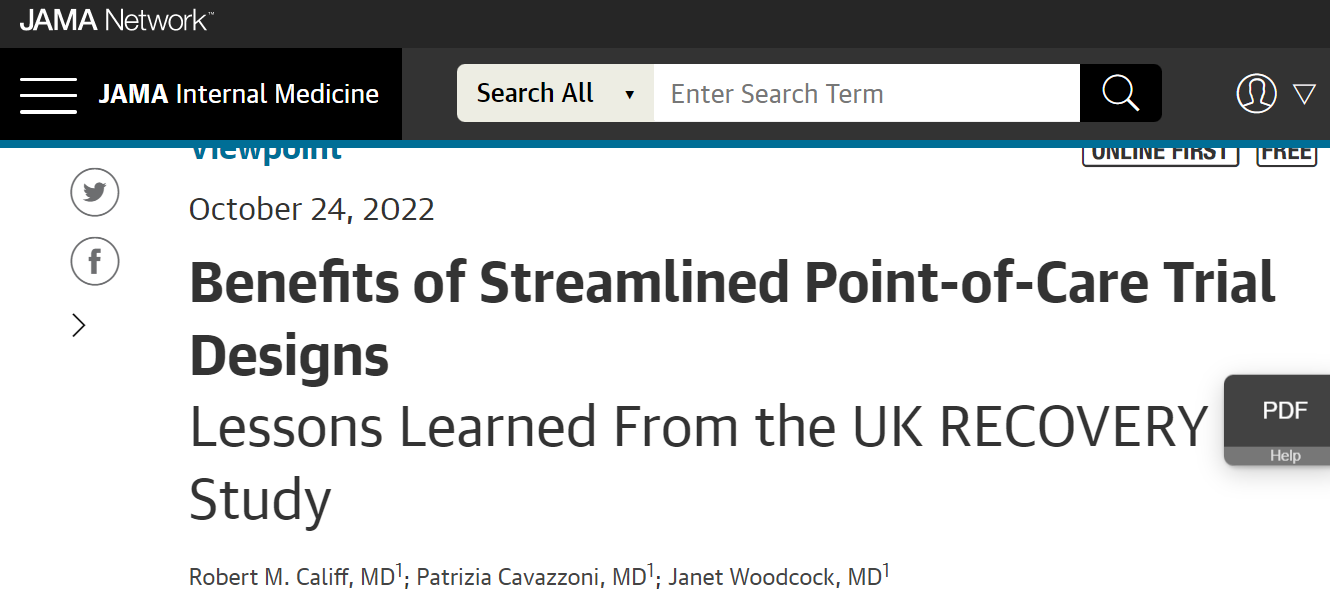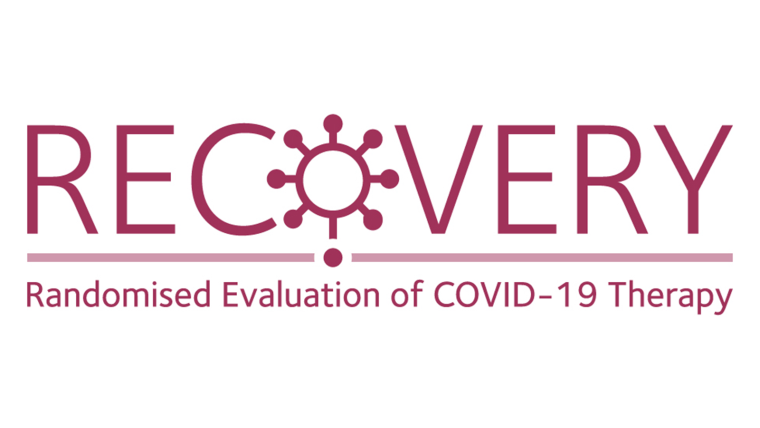JAMA Network
Robert M. Califf, MD1; Patrizia Cavazzoni, MD1; Janet Woodcock, MD1
October 24, 2022
Chief Researcher and Editor of the Portal:
Joaquim Cardoso MSc.
the health transformation
research institute and knowledge portal
October 29, 2022
Executive Summary:
What is the innovation?
- Recent findings from the UK Randomised Evaluation of COVID-19 Therapy (RECOVERY) trial group present an important learning opportunity for the clinical and clinical research communities.
- The RECOVERY trial evolved from a lineage of clinical research2 in which investigators focus efforts on conducting randomized clinical trials that answer critical questions in clinical care settings rather than in specialized research environments.
What is the difference?
- These trials are notable for being “streamlined,” meaning that participant consent forms, data collection instruments, and research procedures are simplified.3
- The term point-of-care trial is used to describe this approach to clinical research.
What are the principles?
- This method of focusing on key attributes of clinical trials that produce reliable, clinically meaningful results uses a concept termed quality by design, …
- A nontrivial aspect of this approach for clinical trials is that larger sample sizes can be enrolled when resources are devoted to achieving reliable estimates of treatment effects that matter, …
- … rather than being absorbed by extraneous, labor-intensive activities that substantially increase the cost of trials without commensurate benefits.
What is the context of the UK?
- The unique environment of the UK National Health Service enables investigators to follow this streamlined approach to clinical research,
- … in which the conduct of clinical trials is integrated directly into clinical care rather than requiring the creation of a separate parallel infrastructure for clinical research.
- Furthermore, a national investment in aggregating data from electronic health records reduces the expensive labor needed for data collection, especially for following up with research participants after hospitalization.
What is the context of the US?
- The current configuration of the US health care system, characterized by disaggregated elements whose incentive structures often do not support integrated services, makes implementation of an integrated research system difficult.
- Specific incentives and support structures will be needed.
- As the safety of therapeutics used during the COVID-19 pandemic is monitored, findings from the RECOVERY trial and the study’s background context are pertinent to practice in the US.
What are the key points about drug safety exemplified by the findings of the RECOVERY trial?
- 1.First, researchers continue to learn about risks and benefits of drugs throughout their life cycles and identify new uses for existing therapies.
- 2.Second, evidence from large point-of-care trials can offer efficient means for estimating the effects of an intervention on major outcomes, particularly in postmarket settings.
What is the transferability to the US? What are the limitations?
- Patients in the US would be more likely to benefit from novel findings of effectiveness earlier if a similar streamlined approach to clinical trials were adopted.
- The COVID-19 pandemic has seen substantial resources directed to small, underpowered trials of repurposed drugs evaluated for novel uses that have often failed to provide clear and actionable answers. In a pattern observed before 9 and during10 the pandemic, many patients volunteered for studies that were too small or whose design was inadequate for answering critical clinical questions.
- Because most of these small, low-yield trials are conducted in academic medical centers, additional attention to proposed protocols is needed to focus enrollment efforts on studies capable of yielding actionable information.
- Although observational epidemiologic studies are valuable, many important questions can only be answered by randomized trials (including those using pragmatic methods) to achieve enough outcomes for a reliable estimate of the causal effect of the intervention.
What does it take?
- To increase the number of trials that address these important practice-based questions using point-of-care methods, academic incentives and ethics will be important drivers of change.
- Although the FDA has limited authority to require point-of-care trials, the agency seeks to encourage such trials …
- … and would incorporate relevant information into labeling when appropriate, as long as the trials are conducted in a manner consistent with regulatory requirements.
- Research funding and academic incentives should be aligned with this important societal need.
What are the benefits:
- Given the resources, technology, and talent in the US, our knowledge of the risks and benefits of interventions could be greatly enhanced with focused, pragmatic point-of-care trial designs.
ORIGINAL PUBLICATION (full version)

Benefits of Streamlined Point-of-Care Trial Designs- Lessons Learned From the UK RECOVERY Study
JAMA Network
Robert M. Califf, MD1; Patrizia Cavazzoni, MD1; Janet Woodcock, MD1
October 24, 2022
Recent findings from the UK Randomised Evaluation of COVID-19 Therapy (RECOVERY) trial group present an important learning opportunity for the clinical and clinical research communities.
The trial’s data monitoring committee stopped enrollment of a subgroup of participants in a study that compared a high-dose regimen of the steroid dexamethasone (single daily doses of 20 mg for 5 days followed by 10 mg for 5 days) with 6 mg administered daily to patients admitted to the hospital with COVID-19 and hypoxia.1
Patients with documented hypoxia requiring no or simple oxygen without further mechanical support would no longer be enrolled in the trial because the data monitoring committee observed a signal for excess mortality in the study group receiving high-dose dexamethasone.
The RECOVERY investigators had previously shown that 6 mg of dexamethasone administered daily for 10 days or until hospital discharge substantially reduced mortality among these patients, but that the use of steroids in patients without hypoxia had no benefit and carried significant risk.1
The RECOVERY trial evolved from a lineage of clinical research2 in which investigators focus efforts on conducting randomized clinical trials that answer critical questions in clinical care settings rather than in specialized research environments.
These trials are notable for being “streamlined,” meaning that participant consent forms, data collection instruments, and research procedures are simplified.3
The term point-of-care trial is used to describe this approach to clinical research.
The RECOVERY trial evolved from a lineage of clinical research2 in which investigators focus efforts on conducting randomized clinical trials that answer critical questions in clinical care settings — rather than in specialized research environments.
These trials are notable for being “streamlined,” meaning that participant consent forms, data collection instruments, and research procedures are simplified.3
This method of focusing on key attributes of clinical trials that produce reliable, clinically meaningful results uses a concept termed quality by design, …
… first articulated by Romanian-born US engineer and quality expert Joseph M. Juran (1904–2008) and used by multiple industries and manufacturing systems as well as the US Food and Drug Administration (FDA).
Quality by design is used to systematically reduce meaningful errors by enabling the enterprise to focus on essential elements of a process while reducing or eliminating superfluous procedures that distract from critical components.
Quality by design is used to systematically reduce meaningful errors by enabling the enterprise to focus on essential elements of a process while reducing or eliminating superfluous procedures that distract from critical components.
A nontrivial aspect of this approach for clinical trials is that larger sample sizes can be enrolled when resources are devoted to achieving reliable estimates of treatment effects that matter, rather than being absorbed by extraneous, labor-intensive activities that substantially increase the cost of trials without commensurate benefits.
A nontrivial aspect of this approach for clinical trials is that larger sample sizes can be enrolled when resources are devoted to achieving reliable estimates of treatment effects that matter, rather than being absorbed by extraneous, labor-intensive activities that substantially increase the cost of trials without commensurate benefits.

The unique environment of the UK National Health Service enables investigators to follow this streamlined approach to clinical research, …
… in which the conduct of clinical trials is integrated directly into clinical care rather than requiring the creation of a separate parallel infrastructure for clinical research.
Furthermore, a national investment in aggregating data from electronic health records reduces the expensive labor needed for data collection, especially for following up with research participants after hospitalization.
The current configuration of the US health care system, characterized by disaggregated elements whose incentive structures often do not support integrated services, makes implementation of an integrated research system difficult.
Specific incentives and support structures will be needed.

As the safety of therapeutics used during the COVID-19 pandemic is monitored, findings from the RECOVERY trial and the study’s background context are pertinent to practice in the US.
Excessive use of steroids to treat COVID-19 has already been observed in outpatients in the US, particularly in some regions.4
Given the signal of major benefit with appropriately dosed steroids when used for hospitalized patients with clinical evidence of hypoxia as well as the documented risk of inappropriate treatment, clinicians should follow the evidence so this treatment is used appropriately for those who are likely to benefit and is eschewed for those likely to be harmed.

Several key points about drug safety are exemplified by the findings of the RECOVERY trial.
- 1.First, researchers continue to learn about risks and benefits of drugs throughout their life cycles and identify new uses for existing therapies.
- 2.Second, evidence from large point-of-care trials can offer efficient means for estimating the effects of an intervention on major outcomes, particularly in postmarket settings.
1.First, researchers continue to learn about risks and benefits of drugs throughout their life cycles and identify new uses for existing therapies.
For example, steroids have been available as generic drugs for decades, and emerging scientific evidence can support new indications.
In another example, niacin was used as a low-density lipoprotein cholesterol–lowering therapy in patients with cardiovascular disease for decades based on presumed benefit from the Coronary Drug Project conducted in the 1960s, before effective low-density lipoprotein–lowering agents such as statins were available.5
Subsequent cardiovascular outcome trials failed to show a reduction in cardiovascular risk when niacin was added to statin therapy and also identified serious adverse events.6,7
It is important that labels reflect additional relevant data as they emerge throughout a drug’s life cycle.
However, surprising benefits may also be found.
For example, when the FDA required long-term safety studies for drugs developed to treat type 2 diabetes, several classes of drug were found to produce surprising and profound reductions in risks of death and serious morbid cardiovascular events.8
2.Second, evidence from large point-of-care trials can offer efficient means for estimating the effects of an intervention on major outcomes, particularly in postmarket settings.
Incorporating new long-term data for prescriber and patient education is a shared responsibility of the FDA and clinical practice guideline groups.
The streamlined approach used by such trials, leveraging quality-by-design principles to achieve simple trial protocols, focuses on practical methods that can enhance statistical power and participation.
This simplicity and clarity can enable adequate sample sizes for reliable estimates of outcome and encourage participation of clinicians and patients — all at a low cost per participant.
Streamlined point-of-care trials can also expand research into more health care settings, thereby helping to generate information about the safety and efficacy of regulated medical products in diverse populations, including those who are often underrepresented in clinical trials.

Patients in the US would be more likely to benefit from novel findings of effectiveness earlier if a similar streamlined approach to clinical trials were adopted.
The COVID-19 pandemic has seen substantial resources directed to small, underpowered trials of repurposed drugs evaluated for novel uses that have often failed to provide clear and actionable answers.
In a pattern observed before 9 and during10 the pandemic, many patients volunteered for studies that were too small or whose design was inadequate for answering critical clinical questions.
Because most of these small, low-yield trials are conducted in academic medical centers, additional attention to proposed protocols is needed to focus enrollment efforts on studies capable of yielding actionable information.
Although observational epidemiologic studies are valuable, many important questions can only be answered by randomized trials (including those using pragmatic methods) to achieve enough outcomes for a reliable estimate of the causal effect of the intervention.
To increase the number of trials that address these important practice-based questions using point-of-care methods, academic incentives and ethics will be important drivers of change.
Some have argued that it is unethical to enroll patients in a clinical study that, because of fundamental design limitations, cannot answer a question in a way that will advance scientific knowledge or improve clinical practice.
In addition, academic promotion often values authorship of peer-reviewed publications and leadership of trials more highly than contributions to larger point-of-care studies that answer critical questions about health outcomes.
Thus, investigators are understandably attracted to small studies filling a knowledge niche that will give them a chance to be a first author and a principal investigator.

Although the FDA has limited authority to require point-of-care trials, the agency seeks to encourage such trials …
… and would incorporate relevant information into labeling when appropriate, as long as the trials are conducted in a manner consistent with regulatory requirements.
The FDA also plans to convene clinical research funders to develop a glossary of clinical research terminology that will increase the likelihood that a given term’s meaning will be widely understood.
Ambiguous terminology is a source of error and waste in our clinical research system.
The US Centers for Medicare & Medicaid Services and private payers may play a role in offering incentives or establishing requirements through coverage with evidence development for postmarket evidence generation to fill gaps in evidence needed to understand clinical outcomes in various populations and circumstances.
Research funding and academic incentives should be aligned with this important societal need.
Given the resources, technology, and talent in the US, our knowledge of the risks and benefits of interventions could be greatly enhanced with focused, pragmatic point-of-care trial designs.
Streamlining and quality are not opposed; rather, by applying quality-by-design principles, reliable evidence can be developed with planned, measurable quality when researchers focus on ensuring both the quality of data that address important research questions and trial conduct that protects patient safety.
Providing incentives for such approaches could accelerate development of information on drug effectiveness and safety, giving US clinicians and patients earlier access to critical knowledge and advancing public health.
Providing incentives for such approaches could accelerate development of information on drug effectiveness and safety, giving US clinicians and patients earlier access to critical knowledge and advancing public health.
References:
See the original publication
About the authors & affiliations:
Robert M. Califf, MD 1;
Patrizia Cavazzoni, MD 1;
Janet Woodcock, MD 1
1 US Food and Drug Administration, Silver Spring, Maryland
Originally published at: https://jamanetwork.com












